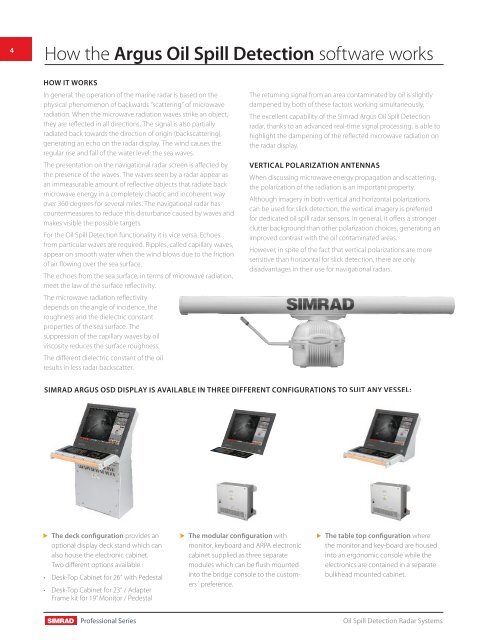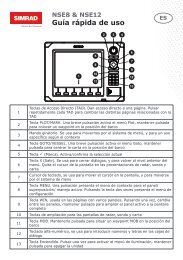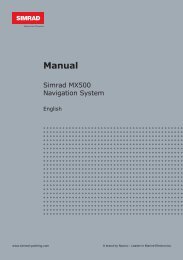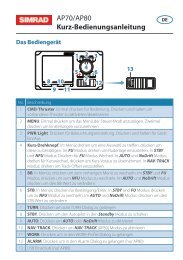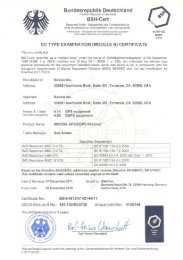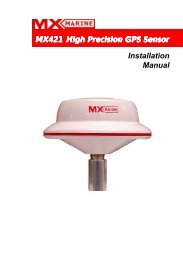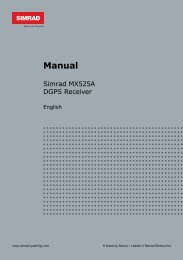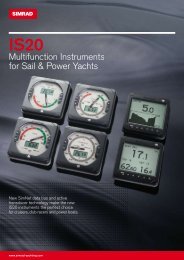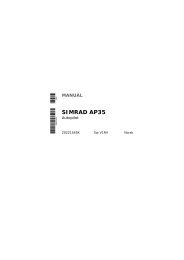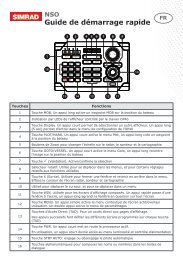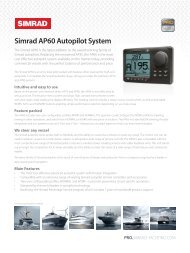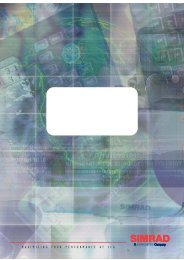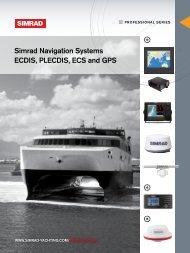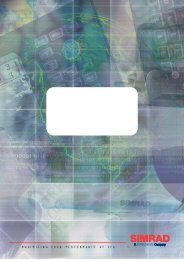Oil Spill Detection - Simrad Professional Series
Oil Spill Detection - Simrad Professional Series
Oil Spill Detection - Simrad Professional Series
Create successful ePaper yourself
Turn your PDF publications into a flip-book with our unique Google optimized e-Paper software.
4<br />
How the Argus <strong>Oil</strong> <strong>Spill</strong> <strong>Detection</strong> software works<br />
How it works<br />
In general, the operation of the marine radar is based on the<br />
physical phenomenon of backwards “scattering” of microwave<br />
radiation. When the microwave radiation waves strike an object,<br />
they are reflected in all directions. The signal is also partially<br />
radiated back towards the direction of origin (backscattering),<br />
generating an echo on the radar display. The wind causes the<br />
regular rise and fall of the water level: the sea waves.<br />
The presentation on the navigational radar screen is affected by<br />
the presence of the waves. The waves seen by a radar appear as<br />
an immeasurable amount of reflective objects that radiate back<br />
microwave energy in a completely chaotic and incoherent way<br />
over 360 degrees for several miles. The navigational radar has<br />
countermeasures to reduce this disturbance caused by waves and<br />
makes visible the possible targets.<br />
For the <strong>Oil</strong> <strong>Spill</strong> <strong>Detection</strong> functionality it is vice versa. Echoes<br />
from particular waves are required. Ripples, called capillary waves,<br />
appear on smooth water when the wind blows due to the friction<br />
of air flowing over the sea surface.<br />
The echoes from the sea surface, in terms of microwave radiation,<br />
meet the law of the surface reflectivity.<br />
The microwave radiation reflectivity<br />
depends on the angle of incidence, the<br />
roughness and the dielectric constant<br />
properties of the sea surface. The<br />
suppression of the capillary waves by oil<br />
viscosity reduces the surface roughness.<br />
The different dielectric constant of the oil<br />
results in less radar backscatter.<br />
The returning signal from an area contaminated by oil is slightly<br />
dampened by both of these factors working simultaneously.<br />
The excellent capability of the <strong>Simrad</strong> Argus <strong>Oil</strong> <strong>Spill</strong> <strong>Detection</strong><br />
radar, thanks to an advanced real-time signal processing, is able to<br />
highlight the dampening of the reflected microwave radiation on<br />
the radar display.<br />
Vertical Polarization Antennas<br />
When discussing microwave energy propagation and scattering,<br />
the polarization of the radiation is an important property.<br />
Although imagery in both vertical and horizontal polarizations<br />
can be used for slick detection, the vertical imagery is preferred<br />
for dedicated oil spill radar sensors. In general, it offers a stronger<br />
clutter background than other polarization choices, generating an<br />
improved contrast with the oil contaminated areas.<br />
However, in spite of the fact that vertical polarizations are more<br />
sensitive than horizontal for slick detection, there are only<br />
disadvantages in their use for navigational radars.<br />
<strong>Simrad</strong> Argus OSD display is available in three different configurations to suit any vessel:<br />
The deck configuration provides an<br />
optional display deck stand which can<br />
also house the electronic cabinet.<br />
Two different options available :<br />
• Desk-Top Cabinet for 26“ with Pedestal<br />
• Desk-Top Cabinet for 23“ / Adapter<br />
Frame kit for 19” Monitor / Pedestal<br />
The modular configuration with<br />
monitor, keyboard and ARPA electronic<br />
cabinet supplied as three separate<br />
modules which can be flush mounted<br />
into the bridge console to the customers´<br />
preference.<br />
The table top configuration where<br />
the monitor and key-board are housed<br />
into an ergonomic console while the<br />
electronics are contained in a separate<br />
bulkhead mounted cabinet.<br />
<strong>Professional</strong> <strong>Series</strong><br />
<strong>Oil</strong> <strong>Spill</strong> <strong>Detection</strong> Radar Systems


